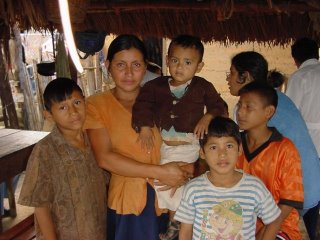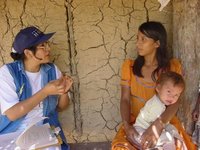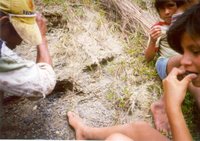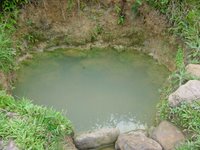 Family of the health promoter in Pamashto, in the Amazon basin of Peru. The promoter is a mestizo and his wife a Lamisto (Quechua -speaking) indian
Family of the health promoter in Pamashto, in the Amazon basin of Peru. The promoter is a mestizo and his wife a Lamisto (Quechua -speaking) indianThe Financial officer at the University quickly accepted my offer. I would receive a small fund to start a health project in the Huallaga Valley, in the Peruvian Amazon Basin. If I failed to get funding, he would recover in installments all expenses incurred from my meager academic salary.
We immediately started activities in Uchiza, at a time when the leading cause of death among adult men still was firearm injuries, a legacy of times when Shining Path guerillas battled government forces and other subversive groups. Aquilina Palomino, a RN, used an iron-fortified chocolate drink to fight anemia. She had obtained strong community participation and encouraging results in reducing severe anemia.
Initially, the local USAID Mission rejected an unsolicited proposal Aqulina wrote. After Garcia's administration ended, Peru was included again in the list of eligible countries for USAID funding. A US-based nonprofit contacted the School of Public Health where I worked. After a convoluted process, I ended up directing a Child Survival project in the Huallaga Valley that included the control of micronutrient deficiencies as one of the main interventions.

The results of the baseline household survey were puzzling. In one of the provinces, Lamas, less than 1/6 of women were anemic, while the overall rate was over 30%. Less than 10% of Lamisto had taken iron supplements and the local diets provided very little absorbable iron. What was protecting Lamisto women from anemia? while it is true that Lamas is located at a higher altitude, where malaria and hookworm are less common, poverty is worse there (photo at the right shows RN Nancy Garcia interviewing a Lamisto mother in Aviacion).
Cesar Eduardo Wong, a MD student visited Lamas during a summer vacation. The family of the health promoter in Pamashto explained everything to CEW: women consumed metalillo, a clay rich in absorbable iron as we found when submitted this clay for chemical analysis. A teaspoon of meta
 lillo contains as much absorbable iron as 40 hamburgers! Sadly, chemical analysis supported by Luis Seminario (USAID) also found that metalillo has traces of lead that makes it unsuitable for human consumption.
lillo contains as much absorbable iron as 40 hamburgers! Sadly, chemical analysis supported by Luis Seminario (USAID) also found that metalillo has traces of lead that makes it unsuitable for human consumption.
Margarita Huaman, an anthropologist, spent three months doing participatory observation in Pamashto and Lamas. See one of her photos at the right, these kids are eating metalillo from the source. Margarita concluded that most aboriginal women, particularly when pregnant, consumed metalillo, that tastes like roasted peanuts after being heated and smoked. If you are interested in the ethnography of geophagia (technical word for eating dirt), go to Lima's Catholic University and read Margarita's dissertation. Also, watch the documentary my nephew Mario Vildosola Jr. made on geophagia in Lamas.
 Lamistos in Pamashto -where tap water is available- still retrieve drinking water from this open well. The white soil layer near the interphase air-water is metalillo.
Lamistos in Pamashto -where tap water is available- still retrieve drinking water from this open well. The white soil layer near the interphase air-water is metalillo.Lamistos have other tasty treats. When my kids visited Lamas they had fun eating their deep fried ants.
No comments:
Post a Comment